This manual was prepared to inform Tennessee farmers and firefighters about causes, prevention and control of silo fires. The information contained herein is believed to be accurate and up-to-date. However, the University of Tennessee Agricultural Extension Service will not be responsible for accidents, injuries nor any other losses resulting from the application of practices described in this publication.Portions reprinted with permission from the publication "Extinguishing Silo Fires" published by the Northeast Regional Agricultural Engineering Service, Riley Robb Hall, Cornell University, Ithaca, NY 14853.
Occasionally, we hear reports of an upright or tower silo containing a fire. The majority of these silo fires are slow, smoldering ordeals that become a frustration to farmers and fire fighters. A few have resulted in raging fires or explosions, some with fire fighters being injured or killed.
A variety of conditions are possible when fires are in conventional silos. Often, the first sign of fire is a piece of burned door that falls down the chute. Other signs may be blackened or glowing red silage, smoke pouring out of the silo or a burnt odor around the silo.
Burning silage in silos can be hazardous. Know what the hazards are and act accordingly. Of course, the best way of dealing with silo fires is by preventing them.
WHAT CAUSES SILO FIRES?
The more troublesome fires, however, are those resulting from spontaneous ignition within the stored silage. The leading cause of this type fire is low moisture silage and air leaks in the silo. Air enters the silo through cracks in the walls or around poorly fitting doors. Poor distribution of material during filling may result in poor compaction and contribute to fires.
Silage is formed when forage crops are allowed to ferment in the absence of air. The bacteria responsible for fermentation produce a certain amount of heat, thus silage will be fairly warm during this process. Low moisture content and the presence of oxygen may allow the microorganisms to reproduce too rapidly and generate heat faster than normal. The silage surrounding an area with excessive heat generation acts as insulation, so temperatures can climb quite high and combustion may occur.
PREVENTING SILO FIRES
 Silos should be inspected at least annually and any damage
repaired. Look for structural weaknesses and seal any cracks
which could allow air to reach the ensiled crop materials.
If the wall can be readily scratched with a coin or if scaling
is detected have the wall treated or sealed. Don't forget
to check the doors to see that they fit properly. Replace
any doors showing signs of decay, as they could result in
a fall should a step break loose when someone climbs the chute.
Silos should be inspected at least annually and any damage
repaired. Look for structural weaknesses and seal any cracks
which could allow air to reach the ensiled crop materials.
If the wall can be readily scratched with a coin or if scaling
is detected have the wall treated or sealed. Don't forget
to check the doors to see that they fit properly. Replace
any doors showing signs of decay, as they could result in
a fall should a step break loose when someone climbs the chute.
Harvest crops at the proper moisture content (see Table 1) and distribute the material properly inside the silo. Proper distribution results in better compaction and keeps air from reaching the feed. Proper distribution also increases silo capacity and places a more even load on the silo walls, avoiding possible structural damage (see Figure1).
When the silo is empty, inspect and repair the unloader system. Check all belts, bearings, wiring and motors and repair any damage. Inspect and lubricate the unloader lift cable to prevent a dropped unloader. If the lift cable shows any indications of a kink, cut or corrosion, replace it immediately. Carefully examine the unloader power cable for damaged insulation and terminals. Nicks in the outer insulation may be safely repaired with electrical tape, but more serious damage will require replacement of the cable.
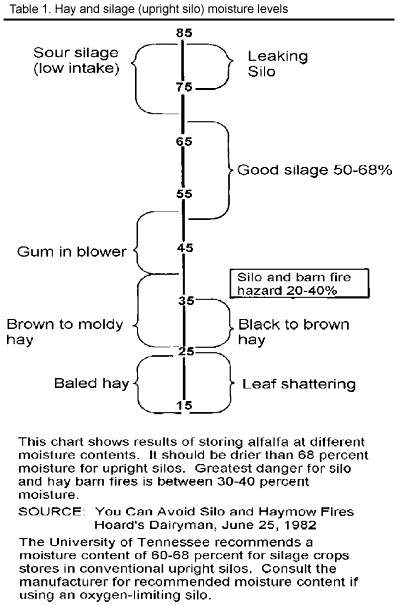
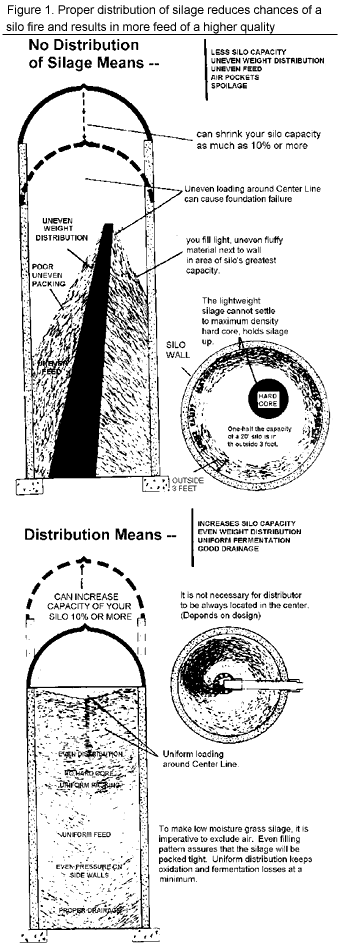
Conventional Silo
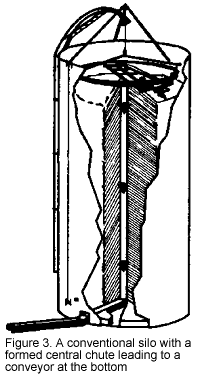 Conventional upright silos are typically constructed of concrete
staves held together by pre-tensioned steel rods (see Figure
2). Some may be built of wood, reinforced concrete, glazed tile
or brick. A few oxygen-limiting silos have been converted to
conventional, top-unloading type. These silos are filled and
unloaded from the top. The unloader rests on the feed surface
and removes a layer of silage as it rotates. A blower sends
the material out one of the doors and down the outside chute
for feeding.
Conventional upright silos are typically constructed of concrete
staves held together by pre-tensioned steel rods (see Figure
2). Some may be built of wood, reinforced concrete, glazed tile
or brick. A few oxygen-limiting silos have been converted to
conventional, top-unloading type. These silos are filled and
unloaded from the top. The unloader rests on the feed surface
and removes a layer of silage as it rotates. A blower sends
the material out one of the doors and down the outside chute
for feeding.
The wooden unloading doors typically have a latch mechanism and metal rungs which serve as a ladder inside the chute. The typical chute is approximately 36 inches wide and 28 inches deep, so movement with an air pack or a second person (accident victim) is difficult. Some conventional silos ave an inside chute which is formed as the silo is filled (Figure 3). The top unloader operates similarly to those in other conventional silos, except the silage drops down this inside chute to a conveyor at the bottom.
When a silo fire is detected, call the fire department immediately. After the fire department is notified, farmers should attempt to close the bottom of the chute to limit air movement through it until the fire department arrives. Air moving through the chute will fan the fire. Use select metal or other non-combustible materials to close the chute.
Remove livestock and machinery form exposed and adjacent buildings. Wet the area around the silo to keep the fire from spreading. Cover openings in nearby buildings with non-combustible materials to keep out sparks or embers.
Be alert to the presence of toxic gases inside silos (see Table 2). IF only light puffs of smoke are visible, it may be safe for inspection and temperature checks without a self-contained breathing apparatus (SCBA). If there is continuing smoke or glowing embers, have the first person who climbs the chute to assess the situation wear a SCBA.
| Table 2. Characteristics of Dangerous Gases That May Be Present in Silos. | |||||||||
| Gas | Health Effects | Exposure Level Maximums* | Physical properties | Flammable Properties | |||||
|---|---|---|---|---|---|---|---|---|---|
| Acute | Long Term | Immediately Dangerous to Life and Health | Short-Term Exposure** | 8-hour Work Day | Density (Air=1) | Color | Odor | ||
| Carbon Monoxide (CO) | Asphyxiant | -- | 1,500 | 400 | 50 | .97 | Colorless | odorless | Explosive between 12.5 % and 74% by volume of air mixture. auto ignites as 1128°F (609°C) |
| Carbon Dioxide (CO2) | Asphyxiant | -- | 50,000 | 15,000 | 5,000 | 1.52 | colorless | odorless | Non-flammable |
| Nitrogen Dioxide (NO2) | Respiratory Irritant | Permanent Lung Damage | 50 | No standard presently in effect | 3 | 1.16 | reddish brown | strong pungent | Non-flammable but will support combustion |
| Nitric Oxide (NO) | Asphyxiant | -- | 100 | 35 | 25 | 1.53 | colorless | strong pungent | Non-flammable but will support combustion |
| * Numbers represent parts of gas per million parts of air (ppm).
** Fifteen-minute exposure, maximum four exposures per eight-hour day with 60-minute intervals between exposures. Carbon monoxide is formed in small quantities during fermentation. Once a fire starts, however, incomplete combustion of cellulosic materials (such as silage) forms larger quantities. Carbon Dioxide is present in small quantities in a flaming fire or after complete combustion. Carbon dioxide is non-flammable and heavier than air. At low concentrations, it is non-toxic, but at higher concentrations, it displaces oxygen and acts as an asphyxiant. Nitric Oxide and Nitrogen Dioxide are poisonous gases which form when nitrogenous organic compounds (such as silage) burn. These gases also occur as by-products of silage fermentation. The highest levels are present during the first 48 hours after the silage is put into the silo, but dangerous levels may persist for up to three weeks. Nitrogen dioxide is the most dangerous and most likely to be present in the silo. |
|||||||||
Whether fire is suspected or evident, use a lifeline and never step directly on the silage surface. Place boards, pieces of plywood or ladders on the surface to distribute weight over a larger area. This will minimize the risk of falling into a burned out cavity.
 The lifeline should be tied as high as possible to a beam,
hoop or other structural member of adequate strength. This
can be a rope from a double bowline soling, a harness or upper
"O" ring on the SCBA. Station a second person in the chute
to observe and assist. Radio communication with the ground
is recommended.
The lifeline should be tied as high as possible to a beam,
hoop or other structural member of adequate strength. This
can be a rope from a double bowline soling, a harness or upper
"O" ring on the SCBA. Station a second person in the chute
to observe and assist. Radio communication with the ground
is recommended.
Auxiliary lighting is often needed in the silo. Lights can be positioned from the silo filling platform.
Step I - Size Up the Situation
If considerable smoke is pouring out of the silo, farmers should not attempt to enter the silo or chute. This should be left to firefighters wearing full turnout gear and a self-contained breathing apparatus (SCBA).
Step 2 - Knockdown Surface Burning
Experience has shown that a straight tip nozzle is more effective than a fog or spray. The stream of water from a straight tip nozzle penetrates the pile and better extinguishes a fire that has become deep seated. A 3/8" tip is recommended. After the surface fire is extinguished, then procedures for extinguishing a subsurface fire are employed.
Remove unloading doors and coverings to allow hot gases, smoke and steam to escape.
Dousing is effective only if water reaches the fire, thus limiting its application to surface burning. One firefighter, in full turnout gear with lifeline and SCBA, dousing from the filling platform or from the chute is usually sufficient to extinguish all surface burning.
CAUTION:
Do not attempt to extinguish a silo fire by pumping large
quantities of water onto the surface of the silage, hoping
it will soak in and cool the fire - it won't work. Water will
not penetrate the silage well enough to control the fire in
this manner. In addition, the silo cannot withstand the higher
lateral pressure created by the water and structural damage
may result (Figure 5).
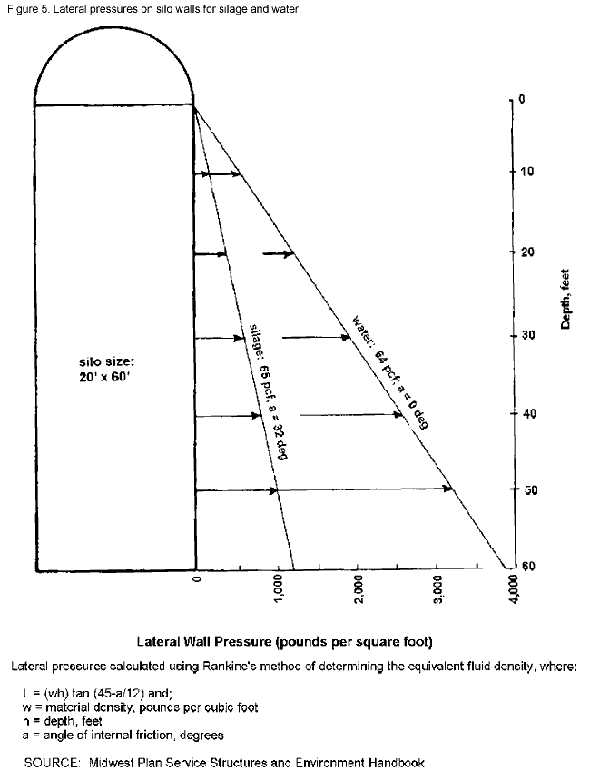
Step
3 - Temperature Readings One of the
keys to extinguishing fires in a conventional silo is to find
the exact location of the fire. This can be done with an easily
constructed probe and a thermometer (Figure 6). Other temperature
sensing devices are available which can be used alone or with
the probe. Each fire department should have a probe and thermometers
to locate hot spots in silage or hay.

A firefighter
standing on a ladder, boards or plywood pushes the probe into
a suspect area and lowers a thermometer into the probe using
a light wire (Figure 7). After a few minutes the thermometer
is retrieved and observed.
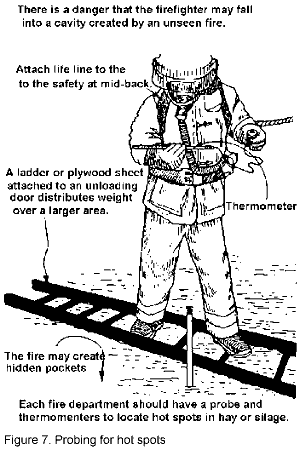
Make several temperature readings, starting near obvious hot spots and moving toward the silo walls at three foot intervals. If the fire is caught in its earliest stages only one hot spot may be present. However, there may be several hot spots because the fire will follow air layette to support itself. Consequently, take several readings across the silage.
How deeply a probe can be pushed into the silage depends on the condition of the silage. A probe will penetrate easily into a charred or burned spot. On the other hand, it is difficult to push the probe more than 4 to 6 feet into packed, finely chopped silage.
Temperatures below 140°F indicate no particular heating problem. Temperatures of 140 to 170°F are difficult to interpret. Heat moves slowly through silage and silo walls, so readings in this range may indicate the silage is heating or it is gaining or losing heat from another hot spot. Repeat the temperature reading every two or three hours to check for dangerous heating. If the temperature is 180°F or higher the silage will eventually char, smolder or burn.
Step 4 - Water Injection After determining the location and extent of the fire, inject water directly into the hot areas using the probe. Work slowly and methodically. Leave the prove in place for several seconds to several seconds to several minutes, depending on the size and temperature of the hot spot. The goal is to cool and raise the moisture content of the hot spot to safe levels.
Water may be injected from the silo chute, especially when a door has burned through. Be prepared for considerable amounts of steam and smoke which may blow back.
The firefighters using the probe must wear full turnout gear and a lifeline. Station a second firefighter, also in full turnout gear, inside the chute to help handle the hose and assist as needed. This is especially important if the probe operator goes inside the silo.
A water gas explosion from injecting water into burning silage is not a realistic concern in conventional silos. The few explosions that have been reported from silage fires have all been in oxygen-limited silos where there was a build-up of explosive gases.
The water gas reaction occurs when water molecules react with very hot carbon to form hydrogen and carbon monoxide. The reaction is highly endothermic, or it absorbs heat, so the temperature of the material drops rapidly. Consequently, when water hits the hot silage, the instantaneous cooling effectively prevents the water gas reaction.
Another important factor practically prevents explosions in conventional silos. For an explosion to occur, there must be containment of the right proportion of air (or oxygen and an explosive gas (like carbon monoxide). There is no containment of gases in a conventional silo.
Water
Additives
Fire in a silo does not change the characteristics of chemicals
that may be added to water as an aid for extinguishment. Chemicals
that help water to absorb heat would do the same if used on
a silo fire. If mixed according to the label, there are no
adverse effects to the silage. Chemicals that reduce water
friction do not hurt, but are of no particular help because
large quantities of water are not generally used.
Gases, such as carbon dioxide or nitrogen, may be injected into conventional silo fires in a manner similar to injecting water. The expense of these materials and cold weather problems make water a better choice. In addition, gases do not correct the major cause of silo fires - dry material.
Step 5 - Unload the Silo Unload the damaged silage because:
There is a section later in this manual which covers some of the problems or potential hazards to consider when unloading the silo.
Advanced
Fires in Conventional Silos
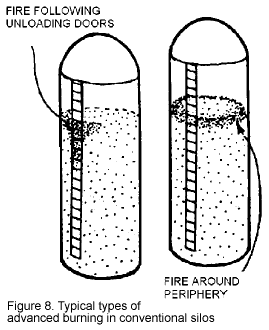 A silo fire may smolder or burn for days or even weeks before
discovery. A silo fire in the advanced stages rarely remains
below the surface or deep within the mass of silage. Instead,
it travels horizontally toward the walls of the silo or vertically
to the upper surface of the silage (Figure 8).
A silo fire may smolder or burn for days or even weeks before
discovery. A silo fire in the advanced stages rarely remains
below the surface or deep within the mass of silage. Instead,
it travels horizontally toward the walls of the silo or vertically
to the upper surface of the silage (Figure 8).
Silage shrinks as it dries and becomes excellent fuel for a fire. There may be an air space as much as several inches wide between the silage and the silo wall. Unloading doors in a conventional silo often leak air and permit a column of silage to dry and shrink for some distance down the silo. This leaves a column of dry fuel along the doors.
When
fire reaches any of these areas of dry fuel and abundant air
it burns freely rather than smoldering. If this occurs, attack
the surface fire before attacking the subsurface fire.
Experience
has shown that a straight tip nozzle is more effective than
a fog nozzle on silo fires. The solid stream of water from
a straight tip penetrates the burning material better. A 3/8
inch tip is recommended.
Fire Along the Unloading Doors Fire along the column of dry silage behind the unloading doors is the most common example of advanced burning in a conventional silo. Attack these fires as follows:
NOTICE: In some cases the fire may be so advanced that extinguishing the fire is impractical. For example, if the fire started near the bottom of the silo and has progressed to the top of the chute as well as several feet back into the silage, it may be best to allow the fire to burn out on its own. It is possible to put out the fire, but it may reignite and unloading will be dangerous. If it is determined to allow the fire to burn out, take steps to prevent spread of the fire. Be aware that the fire may smolder for several weeks or months.
Fire in a Horizontal Pattern The next most common example of an advanced fire is burning around the silo wall. The burn pattern is usually a trench-like burned area around the silo three or four feet deep. Attack these fires as follows:
Oxygen-Limiting
Silos
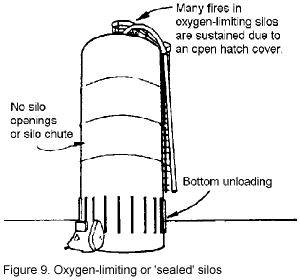 Oxygen-limiting or "sealed" silos are exactly what their name
implies. Properly managed silos of this type contain very little,
if any, oxygen. This is intended to keep spoilage to an absolute
minimum, resulting in a higher quality feed. Oxygen-limiting
silos have no outside chute and unload from the bottom (Figure
9). Top hatches and unloader doors are to remain closed except
when they are being used. The most common brand of oxygen-limiting
silo in Tennessee is Harvestore.
Oxygen-limiting or "sealed" silos are exactly what their name
implies. Properly managed silos of this type contain very little,
if any, oxygen. This is intended to keep spoilage to an absolute
minimum, resulting in a higher quality feed. Oxygen-limiting
silos have no outside chute and unload from the bottom (Figure
9). Top hatches and unloader doors are to remain closed except
when they are being used. The most common brand of oxygen-limiting
silo in Tennessee is Harvestore.
Spontaneous ignition fires in oxygen-limiting or "sealed" silos are rare, but they can occur with improper management. The basic rule for these silos is to keep all openings closed, except when filling the silo or operating the unloader. Excluding air preserves the silage and prevents fire. Even with drier silage at 45 percent moisture content, there is usually insufficient oxygen to support a fire after an oxygen-limiting silo is filled and sealed, A slow charring fire will sometimes suffocate due to insufficient oxygen.
A fire in an oxygen-limiting silo is potentially very dangerous. There have been explosions when firefighters attempted to extinguish the fires. To prevent explosions, do nothing that could allow oxygen to enter the silo. Follow proper procedures for maximum safety.
The airspace above the silage in an oxygen-limiting silo will contain smoke and carbon monoxide along with other gases and some oxygen during a fire. Any action which introduces additional oxygen may produce an explosive atmosphere which may be ignited by the burning silage. If this occurs, the pressure created by the burning gases cannot be vented through the top hatch and an explosion will result.
DO NOT USE WATER OR FOAM to fight a fire in an oxygen-limiting silo. Opening the top hatch to apply water or foam will allow oxygen to enter. The stream of water or foam will carry large amounts of air into the silo. In addition, the steam formed when the water reaches the fire may also contribute to an explosion. Signs to warn of this danger are available (Figure 10).
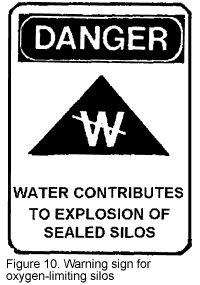 Fires in oxygen-limiting silos are discovered if burnt or
burning material comes out the unloader, or if smoke is escaping
from the top hatch. When a fire is discovered, seal the unloader
opening or hatch. Next, seal all openings such as manhole
covers and drain caps used for maintenance.
Fires in oxygen-limiting silos are discovered if burnt or
burning material comes out the unloader, or if smoke is escaping
from the top hatch. When a fire is discovered, seal the unloader
opening or hatch. Next, seal all openings such as manhole
covers and drain caps used for maintenance.
If the silo is cool and quiet, and if minimal smoke is escaping, carefully climb the silo and close the top hatch or any other openings. Do not lock or latch the top hatch. Closing the hatch will prevent oxygen from entering the silo, yet pressure increases can be relieved safely.
Leave the silo closed for up to three weeks to allow the fire to use all oxygen and self extinguish. During this time, make temperature readings of weekly samples from the unloader to be sure the fire is extinguished.
If the silo is producing considerable smoke or steam, or if the silo is rumbling, leave the hatch alone. Closing the hatch on an active fire could bring carbon monoxide and air mixtures into the explosive range.
If sealing the silo does not extinguish the fire, inject nitrogen or carbon dioxide to displace oxygen and cool the fire. Be careful not to introduce additional oxygen. Most oxygen-limiting silos have pipe nipples for injecting these gases. These nipples should be inspected annually to insure they are open and useable. If nipples are not present, have the farmer install one or have one installed by the manufacturer or dealer. Table 3 lists the amounts of gas needed for various sized silos
| Table 3. CO2 or N2 Quantity Required to Extinguish Fires in Oxygen-Limiting Silos | ||
| Silo
Size (dia x ht (ft)) |
CO2
(no. 50 lb. cylinders) |
N2
(no. 50 lb. cylinders) |
| 20 x 60 | 20 | 40 |
| 20 x 70 | 22 | 44 |
| 20 x 80 | 30 | 60 |
| 24 x 60 | 30 | 60 |
| 24 x 70 | 35 | 70 |
| 24 x 80 | 40 | 80 |
| 30 x 60 | 45 | 90 |
| 30 x 70 | 50 | 100 |
| 30 x 80 | 60 | 120 |
| SOURCE: NRAES-18, Extinguishing Silo Fires | ||
Depending on the quantity and quality of silage remaining, the silo may need to be emptied after the fire cools. With a small amount of poor quality silage, the fire may re-ignite after the carbon dioxide or nitrogen escapes. Fire is not likely to restart if a large amount of good quality silage remains. In any event, do not refill the silo until the silo has been inspected and any repairs made.
AFTER ANY SILO FIRE
UNLOADING
HEAT DAMAGE
Silage below the fire level probably will not be damaged and will not have lost any nutritional value.
WATER DAMAGE
REIGNITION
UNLOADING PRECAUTIONS
Most unloaders are not intended for continuous operation and the motors will overheat unless allowed to cool every half hour. As silage is removed, exposing hot silage could cause a fire as well. While the unloader motor is cooling, probe for hot spots and inject water as needed.
STRUCTURAL DAMAGE
Applying a water fog to the outside of a silo is not recommended by silo manufacturers. This practice causes more structural stress than natural cooling. The result could be more damage than doing nothing at all. It is said that there is no danger of structural collapse even when small areas of the silo become so overheated that they glow. Always inspect a silo and repair damage after any silo fire. The silo dealer or manufacturer and your insurance agent can provide assistance.
FIRES OUTSIDE THE SILO
REFERENCES
| Table 4. Silo Capacity Chart | ||||
| Size | Cu. Ft. | Dry Matter | Approximate Tons | |
| Silage 50% Moisture | Silage 65% Moisture | |||
| 3390 | 21 | 42 | 60 | |
| 4520 | 31 | 62 | 88 | |
| 5650 | 42 | 84 | 121 | |
| 4620 | 29 | 58 | 82 | |
| 14 x 40 | 6160 | 43 | 86 | 123 |
| 14 x 50 | 7700 | 60 | 120 | 171 |
| 14 x 55 | 8464 | 70 | 140 | 201 |
| 16 x 30 | 6030 | 38 | 76 | 109 |
| 16 x 40 | 8040 | 56 | 112 | 161 |
| 16 x 50 | 10050 | 76 | 152 | 218 |
| 16 x 60 | 12060 | 101 | 202 | 288 |
| 18 x 40 | 10160 | 72 | 144 | 206 |
| 18 x 50 | 12700 | 96 | 192 | 274 |
| 18 x 60 | 15240 | 128 | 256 | 365 |
| 18 x 65 | 147 | 294 | 421 | |
| 18 x 70 | 17780 | 161 | 322 | 459 |
| 20 x 40 | 12560 | 90 | 180 | 256 |
| 20 x 50 | 15700 | 118 | 236 | 339 |
| 20 x 60 | 18840 | 158 | 316 | 452 |
| 20 x 65 | 20410 | 183 | 366 | 523 |
| 20 x 70 | 21980 | 199 | 398 | 568 |
| 20 x 80 | 25120 | 245 | 490 | 700 |
| 22 x 40 | 15200 | 109 | 218 | 312 |
| 22 x 50 | 19000 | 151 | 302 | 433 |
| 22 x 60 | 22800 | 192 | 384 | 549 |
| 22 x 70 | 36600 | 241 | 482 | 690 |
| 22 x 80 | 30400 | 299 | 598 | 853 |
| 24 x 50 | 22600 | 174 | 348 | 497 |
| 24 x 60 | 27120 | 228 | 456 | 651 |
| 24 x 70 | 31640 | 288 | 576 | 823 |
| 24 x 80 | 36160 | 360 | 720 | 1027 |
| 26 x 50 | 26500 | 206 | 412 | 590 |
| 26 x 60 | 31800 | 270 | 540 | 771 |
| 26 x 70 | 37100 | 339 | 678 | 969 |
| 26 x 80 | 42400 | 429 | 858 | 1226 |
| 30 x 50 | 35300 | 270 | 540 | 771 |
| 30 x 60 | 42360 | 363 | 726 | 1037 |
| 30 x 70 | 49420 | 470 | 941 | 1344 |
| 30 x 80 | 56480 | 594 | 1188 | 1697 |
| 30 x 90 | 63540 | 771 | 1542 | 2203 |
| 36 x 60 | 61020 | 533 | 1066 | 1522 |
| 36 x 70 | 71190 | 686 | 1373 | 1961 |
| 36 x 80 | 81360 | 891 | 1782 | 2546 |
| 36 x 90 | 91530 | 1041 | 2082 | 2974 |
| 40 x 60 | 75360 | 679 | 1358 | 1939 |
| 40 x 70 | 87920 | 859 | 1718 | 2455 |
| 40 x 80 | 100480 | 1108 | 2216 | 3165 |
| 40 x 90 | 113040 | 1301 | 2602 | 3717 |
APPENDIX
For capacity at a different moisture content, use the following formula:
![]()
Example:
How may tons of 60% moisture silage in 24' x 60' silo?
![]()
SOURCE: Silo Operator's Manual
SILO MANUFACTURERS
After any silo fire or other occurrence which may cause damage to the silo, such as a lightning strike, contact the manufacturer and your insurance agent for assistance.
Memphis Concrete Silo
Post Office Box 12636
Memphis, Tennessee 38112
901-452-5416
(concrete stave silos)
Mast-Lepley Silo Company, Inc.
10641 Highway 36
Covington, Georgia 30209
ATTN: Sam Hay, Jr.
404-786-3031
Clay and Lambert Mfg.
Highway 146 and 393 at 1-71
Buckner, Kentucky 40010
502-222-1411
(galvanized steel silos and a high-moisture grain bin
sometimes used as an oxygen-limiting silo; makers of Herd
King silos)
Dye Enterprises
855 Snowdoun Chambers Road
Montgomery, Alabama 36105
205-288-5348
(concrete stave silos)
George W. Whitesides Company, Inc.
3048 Muhammad Ali Boulevard
Louisville, Kentucky 40212
502-778-4493
(does not build silos, but manufactures silo coatings)
International Silo Association, Inc.
1163 E. Ogden
Suite 705-359
Napierville, Illinois 60540
312-369-4120
(industry association; source of information)
Publication #: PB1307
This document is apart of a series from the Agricultural Engineering Department, University of Tennessee Agricultural Extension Service, Knoxville, Tennessee 37901. Publication date: October 1988.
Timothy G. Prather, Extension Assistant, Agricultural Engineering Department, University of Tennessee Agricultural Extension Service, Knoxville, Tennessee 37901
Disclaimer and Reproduction Information: Information in NASD does not represent NIOSH policy. Information included in NASD appears by permission of the author and/or copyright holder. More